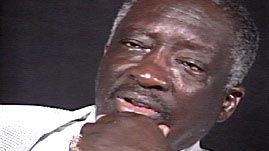Frank Dukes grew up in Fairfield, Alabama, a western suburb of
Birmingham, in the 1930s and 1940s. Dukes attended segregated public
schools, including the all-black Fairfield Industrial High School. He
went on to fight in the Korean War and, like many black veterans,
struggled to reconcile his duty to fight for a country that denied him
civil rights when he returned home. Dukes was 24 years old in 1954 when
the Supreme Court ruled in
Brown v. Board of Education that
segregated schools were unconstitutional. But in Birmingham, where
segregation was often enforced with violence, the promise of equality
was still a long way off.
In 1959, supported by the GI Bill, Dukes enrolled at Miles College, a
predominantly black college on the outskirts of Birmingham. By then, the
Civil Rights movement was gaining momentum. In Birmingham, mass meetings
and demonstrations had mobilized the black community, but they also
activated white resistance. In 1961, civil rights leader Fred
Shuttlesworth won a lawsuit to desegregate the city's 67 public parks.
Police commissioner Eugene "Bull" Connor retaliated by closing
the city's parks.
In 1962, as part of a school project, Dukes conducted research using
information from the Chamber of Commerce to track the buying power of
Birmingham's black population. At the time, African Americans made up 40
percent of the population, and in an average week, they spent $4 million
in downtown stores. However, many stores refused to hire African
Americans or serve them at their lunch counters. Signs in stores
directed them to use separate "colored" water fountains and
restrooms.
Inspired by student protests in other cities and supported by Miles
College president Lucius Pitts, Dukes and fellow students organized a
selective buying campaign, targeting restaurants and stores in downtown
Birmingham that discriminated against African Americans. Initially
business owners didn't take the students seriously.
Hundreds of African Americans signed a petition demanding equal
treatment and fair hiring practices, and the students presented it to
the city commissioners. Connor responded with racial epithets and
suggested that Dukes move to Detroit, Chicago, or some other northern
city. Connor represented the attitude that African Americans were out of
line if they questioned segregation or racial inequalities.
The students met with black women and asked them to boycott the stores
until the demands were met. In addition to boycotting, black women used
their networks to prepare and distribute leaflets, provide
transportation to demonstrations, and raise bail money for demonstrators
who got arrested. The entire black community participated in the
boycott, using their buying power to leverage for equal rights. Because
stores operated on a 12 to 15 percent profit margin, and black dollars
made up 25 percent of the gross revenue, the boycott created an economic
crisis and forced white business owners to listen to the students' demands.
The boycott, which lasted for several weeks, resulted in the removal of
"colored" signs in stores and restaurants, as well as the
unification of the black community. Along with other activities of the
Alabama Christian Movement for Human Rights, the boycott set the stage
for the Reverend Martin Luther King Jr. and the Southern Christian
Leadership Conference's Birmingham campaign, and ultimately led to the
desegregation of Birmingham.

